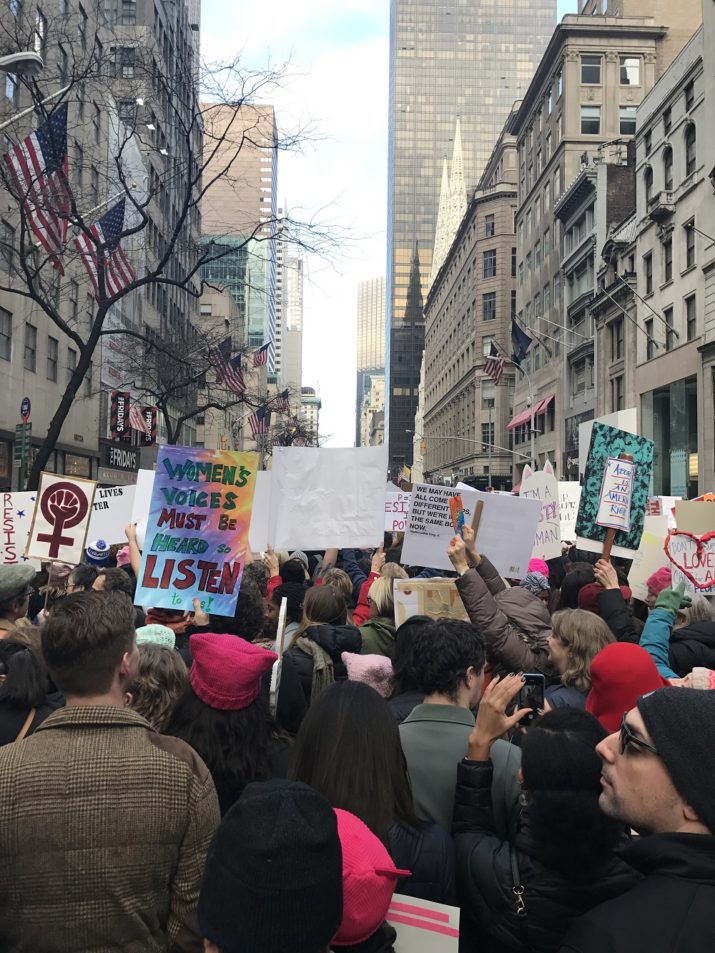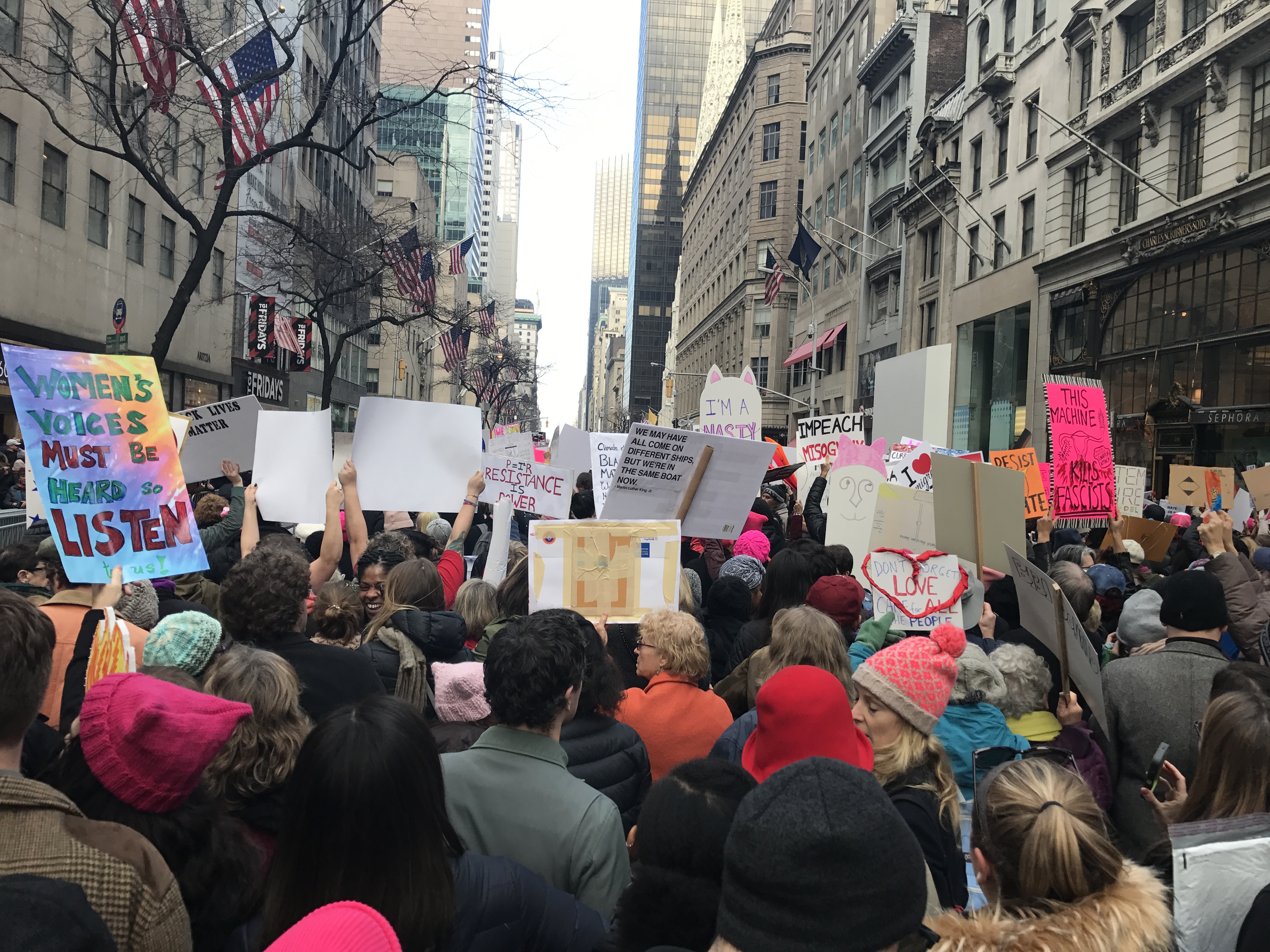

Speaking in front of a crowd at the Women’s March in Washington D.C., feminist icon Gloria Steinem said, “Thank you for understanding that sometimes we must put our bodies where our beliefs are.” The millions that joined the marches around the world proved the effect of simply gathering physical bodies in public spaces. The idea of being one with so many bodies was a pull so strong that even I, a European citizen who moved to the States only two years ago, felt the need to be part of it—to be one of the millions of feet stomping through streets and avenues, cramming against signs and posters that many had cut and drawn in the days before.
It wasn’t just the millions trekking to DC to voice their concerns that caught my attention, but the fact that more than five years after Occupy Wall Street, and almost fifty years after the global movements of 1968, American-bred political turmoil could still compel foreign citizens around the world to take to the streets. People around the world put their bodies where their (anti-Trump) beliefs are, even though their bodies did not stand within American territories, nor could their voice count as a vote in American politics. The global marches seemed like the ultimate symbol of unity, just as much as attending the New York march with a group of European friends, even though we were all able to leave the country if it was necessary.
People around the world put their bodies where their (anti-Trump) beliefs are, even though their bodies did not stand within American territories, nor could their voice count as a vote in American politics.
Yet, the lead up to the march was filled with as many calls for solidarity as criticisms of exclusion. When Teresa Shook, a Hawaiian grandmother, posted the call to march on Facebook the day after the election, she was seeking women to share her outrage. She woke up the next day to tens of thousands of people confirming their attendance, and for a moment, it seemed that the female cause was one that pulled many under one umbrella. The repeated attacks on female bodies by the incoming president and his administration are hard to ignore: a man who boasted about sexual assault, an administration that consists of members who are actively fighting to limit reproductive rights. Pussy grabs back, many of the march’s signs read, as if a shared body part could unite bodies into one.
But can it? Women of color felt unspoken to by the white female organizers, as did women with physical disabilities. Even more so, the organizers were accused of cultural appropriation—initially, the march was called the Million Women March, in reference to the 1997 march that took place in DC for African-American women, which in itself was a reference to Louis Farrakhan’s Million’s March in 1995. After its early days, the white organization undertook major efforts to expand its team to include other identities, yet, despite the march’s many high profile supporters, such as Beyonce and Janelle Monae, many continued to feel excluded from the fight.
The list of principles released by the march’s organization reads less like a plan to grab back the control of female bodies than a reminder to make sure no one is accidentally forgotten from getting an invite. The second line says, “We must create a society in which all women—including Black women, Native women, poor women, immigrant women, Muslim women, lesbian, queer, and trans women—are free and able to care for and nurture their families, however they are formed, in safe and healthy environments free from structural impediments.” All seventeen principles were stated in similar veins, summing up the shades that womanhood consists of to make sure that women from difference experiences, geographies, and backgrounds could walk together.
After the march, few, including myself, could resist the sight of so many bodies marching in the same direction. But no matter how much optimism I felt, I also couldn’t help but count the colored faces in the crowds, while my ability to keep track of the numbers says enough on its own. I couldn’t help thinking of those who stayed home because they didn’t feel as free as the white bodies in the marches—those who have bigger worries, those fearful of deportation, getting their next meal, or the police themselves.
No matter how many people showed up to the marches, the color of the crowd in many locations remained mostly white, even in cities with largely non-white populations. Over 100,000 people gathered in London, even though the UK is currently led by its second female president, no matter how dubious the circumstances of her office. Thousands marched from the American consulate in Amsterdam, even though the steady rise of the Dutch right-wing has never led abortion to become a question in the country’s political discourse. What is the goal of these European marches, if their instigator is the politics of another country? What united the women around the world even though their bodies are not equally under threat?
In European countries with growing right-wing movements, the upcoming elections should serve as a reminder that merging bodies into one space isn’t always enough.
Feminist theorist Nancy Fraser argues that redressing gender injustice involves correcting both maldistribution and misrecognition. In other words, feminism needs to achieve the recognition of different identities in society, as well as the equal distribution of resources among those in it. Not all female bodies are equally under threat, in the US or beyond, and the acknowledgement of the continuous threat to women should go hand in hand with the understanding that some are more at risk than others. Black and colored women experience much higher incidences of emotional and physical assault, while the wealthy will always be able to buy more access to care, whether it concerns reproductive health or not.
In European countries with growing right-wing movements, the upcoming elections should serve as a reminder that merging bodies into one space isn’t always enough. Instead, those in countries like France and the Netherlands, who will elect new governments in March, will need to understand that even in countries where the female body isn’t immediately under threat, female solidarity means voting against the politicians who will hurt and disrespect immigrant and colored bodies more. For men and women in the United States, the march should be followed with a continuous effort to provide extra support to those whose womanhood is at even greater risk.
Leading up to the 21st of January, I’ve had many discussions with friends about what we identify with and with whom we want to stand. No matter how grave the situation in the US, identification with its political turmoil should not cloud the road ahead for those outside its territory. Especially in countries where the political direction of the coming years is yet to be decided, standing in solidarity means more than putting our bodies out there to march as one. It means voting in solidarity with those who cannot afford to march, whose bodies are already too vulnerable to join the crowd, who, for many reasons, are not able to put their bodies where their beliefs are.
Mary Wang is a Chinese-Dutch writer based in New York. Currently, she’s working on a book project that explores Chinese medicine as one of China’s most successful export products.
Photos: The Women’s March in New York City | Mary Wang
Published on January 23, 2017.




